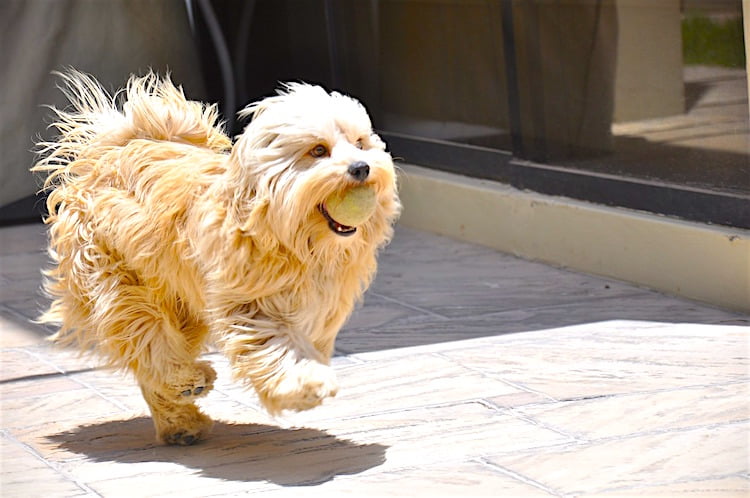Why Does My Dog Run Sideways?
Have you ever noticed your dog running sideways instead of in a straight line? It can be quite amusing and puzzling at the same time. While some dogs may occasionally exhibit this behavior during play or excitement, persistent sideways running may indicate an underlying issue that requires attention.
In this article, we will explore the possible reasons why your dog may be running sideways and what it could mean for their health and well-being. Understanding the causes behind this peculiar behavior can help you provide the necessary care and support for your furry companion.
One possible explanation for sideways running in dogs is a musculoskeletal problem. Dogs, like humans, can experience issues with their bones, joints, or muscles that may affect their gait. Conditions such as hip dysplasia, arthritis, or muscle imbalances can cause discomfort or pain, leading to an altered running pattern. If you notice your dog favoring one side or displaying signs of discomfort while running sideways, it is essential to consult with a veterinarian for a proper diagnosis and treatment plan.
Another factor that may contribute to sideways running is neurological issues. Dogs rely on their nervous system to coordinate their movements, and any disruption in this system can lead to abnormal behaviors. Conditions like vestibular disease, which affects the inner ear and balance, or neurological disorders can cause dogs to lose their sense of direction and run sideways. If you suspect a neurological problem, seeking veterinary advice is crucial for accurate diagnosis and management.

Psychological factors can also play a role in sideways running. Anxiety, fear, or stress can cause dogs to exhibit unusual behaviors, including running sideways. Dogs may feel threatened or overwhelmed in certain situations, leading to a defensive response. Additionally, compulsive behaviors, such as obsessive tail chasing or spinning, can manifest as sideways running. Addressing the underlying emotional triggers and providing appropriate training and behavioral interventions can help alleviate these issues.
Lastly, it is important to consider breed-specific traits and instincts. Some dog breeds have a natural predisposition for certain movements or behaviors. For example, herding breeds like Border Collies may display a tendency to circle or run sideways as part of their instinctual herding behavior. Understanding your dog’s breed characteristics can provide valuable insights into their unique running patterns.
In conclusion, sideways running in dogs can have various causes, ranging from musculoskeletal issues to neurological problems, psychological factors, or breed-specific traits. If you observe your dog consistently running sideways or displaying signs of discomfort, it is crucial to consult with a veterinarian to determine the underlying cause and appropriate course of action. By addressing the root cause and providing necessary care, you can ensure your furry friend’s well-being and help them enjoy their daily activities to the fullest.
Understanding the Reasons Behind Sideways Running in Dogs
Musculoskeletal Issues
One of the primary reasons why dogs may run sideways is due to musculoskeletal problems. Dogs, just like humans, can experience issues with their bones, joints, or muscles that can affect their gait and running pattern. Conditions such as hip dysplasia, where the hip joint is improperly formed, can cause discomfort and pain, leading to an altered running style.
Arthritis, which causes inflammation in the joints, can also contribute to sideways running as dogs try to compensate for the discomfort. Additionally, muscle imbalances or injuries can affect a dog’s ability to run straight, causing them to veer sideways. If you suspect a musculoskeletal issue, it is crucial to consult with a veterinarian who can perform a thorough examination and recommend appropriate treatment options.
Neurological Disorders
Neurological disorders can also be a contributing factor to sideways running in dogs. The nervous system plays a vital role in coordinating a dog’s movements, and any disruption in this system can lead to abnormal behaviors. Conditions such as vestibular disease, which affects the inner ear and balance, can cause dogs to lose their sense of direction and stability, resulting in sideways running. Other neurological disorders, such as brain tumors or spinal cord injuries, can also impact a dog’s coordination and cause them to run in unusual patterns. If you suspect a neurological issue, it is imperative to seek veterinary care to diagnose and manage the condition properly.
Psychological Factors
Psychological factors can influence a dog’s behavior, including sideways running. Dogs may exhibit this behavior as a response to anxiety, fear, or stress. Certain situations or environments may trigger these emotions, causing a dog to run sideways as a defensive or escape response. Additionally, compulsive behaviors, such as obsessive tail chasing or spinning, can manifest as sideways running. These behaviors may stem from boredom, frustration, or a lack of mental stimulation. Addressing the underlying emotional triggers and providing appropriate training and behavioral interventions can help alleviate these issues and reduce sideways running.
Breed-Specific Traits and Instincts
It is essential to consider breed-specific traits and instincts when trying to understand why a dog may run sideways. Some dog breeds have natural predispositions for certain movements or behaviors. For example, herding breeds like Border Collies have an instinctual herding behavior that involves circling and running in a circular pattern. This behavior may translate into sideways running in certain situations. Understanding your dog’s breed characteristics can provide valuable insights into their unique running patterns and help differentiate between normal behavior and potential issues.
Conclusions
In conclusion, understanding the quirky behaviors of our canine companions, such as why does my dog run sideways, can deepen the bond we share with them and ensure their well-being. For more insights into this behavior and other intriguing dog habits, visit our comprehensive guide at Geepets.com. Additionally, if you’re looking for further information on dog health, training, and care, the American Kennel Club (AKC) offers a wealth of resources at akc.org. Both of these resources can provide valuable knowledge and tips to help you understand and care for your furry friend in the best way possible.

Practical Recommendations to Address Sideways Running in Dogs
1. Consult with a Veterinarian
If you observe persistent sideways running in your dog, a behavior that might lead you to ask, “Why Does My Dog Run Sideways,” it is crucial to consult with a veterinarian. They can perform a thorough examination, including musculoskeletal and neurological assessments, to identify any underlying issues that could explain why your dog runs sideways. This question, “Why Does My Dog Run Sideways,” may indicate a variety of health concerns that only a professional can accurately diagnose.
Based on the diagnosis, the veterinarian can recommend appropriate treatment options or refer you to a specialist if necessary, all in the pursuit of addressing the root cause of why your dog runs sideways. This proactive approach is essential for any pet owner who finds themselves repeatedly pondering, “Why Does My Dog Run Sideways,” as it ensures your furry friend receives the care they need for a healthy, happy life.
2. Follow Treatment Plans
If a musculoskeletal problem, such as hip dysplasia or arthritis, is identified as the cause of sideways running, it is important to follow the treatment plan prescribed by the veterinarian. This may include medications for pain relief, physical therapy exercises, weight management, or surgical interventions if required. Adhering to the treatment plan can help alleviate discomfort and improve your dog’s mobility. Understanding “Why Does My Dog Run Sideways” can often lead to the discovery of such underlying health issues.
If you’re asking “Why Does My Dog Run Sideways,” it’s crucial to observe any signs of discomfort or abnormal behavior in your dog that may necessitate a visit to the vet. By addressing the question “Why Does My Dog Run Sideways” with professional input, you can ensure that any musculoskeletal problems causing this peculiar running pattern are properly treated. Keeping the question “Why Does My Dog Run Sideways” in mind and seeking a thorough examination can significantly contribute to your dog’s well-being and quality of life.
3. Address Psychological Factors
If sideways running is attributed to psychological factors, such as anxiety or compulsive behaviors, it is crucial to address these underlying issues. You might wonder, “Why does my dog run sideways?” Understanding that this behavior can stem from emotional distress is the first step.
Enriching your dog’s environment with interactive toys, puzzle feeders, and regular exercise can help alleviate boredom and reduce anxiety, potentially answering the question, “Why does my dog run sideways?” Behavior modification techniques, such as positive reinforcement training, offer another strategy to combat the issue, making you less likely to ask, “Why does my dog run sideways?” Seeking assistance from a professional dog trainer or behaviorist can also be beneficial in managing and redirecting the behavior.
These experts can provide insights and tailored strategies that address the root cause of why you’re asking, “Why does my dog run sideways?” Through these interventions, the aim is to create a more stable and happy environment for your dog, reducing the instances where you find yourself puzzled by their behavior and questioning, “Why does my dog run sideways?”
4. Provide Mental Stimulation
Ensuring your dog receives adequate mental stimulation is essential in preventing or reducing “Why Does My Dog Run Sideways” caused by boredom or frustration. When pondering “Why Does My Dog Run Sideways,” consider engaging in interactive play sessions, teaching new tricks or commands, and providing puzzle toys that require problem-solving skills. Mental stimulation not only keeps your dog’s mind active but also helps redirect their energy into more appropriate behaviors, addressing the concern of “Why Does My Dog Run Sideways.”
The query “Why Does My Dog Run Sideways” often arises when a dog exhibits this behavior as a sign of excess energy or a need for engagement. By focusing on mental stimulation, you’re directly tackling the root cause behind “Why Does My Dog Run Sideways.” This approach ensures that your dog’s need for mental engagement is met, significantly reducing instances where you find yourself asking, “Why Does My Dog Run Sideways?” Remember, a mentally stimulated dog is less likely to display behaviors stemming from boredom or frustration, making the question of “Why Does My Dog Run Sideways” less frequent in your daily experiences with your pet.
5. Consider Breed-Specific Activities
For breeds with instinctual herding or circling behaviors, providing appropriate outlets for these natural tendencies can help reduce sideways running, often leading you to wonder, “Why does my dog run sideways?” Engage in activities such as agility training, obedience trials, or herding classes that allow your dog to channel their energy and instincts in a controlled and constructive manner. This approach can help fulfill their breed-specific needs and minimize sideways running outside of these designated activities, addressing the question, “Why does my dog run sideways?”

Incorporating these activities into your dog’s routine not only mitigates the puzzling behavior of sideways running but also enriches their mental and physical well-being, making the query “Why does my dog run sideways?” less of a concern. By understanding and catering to the root of the behavior, which prompts the question “Why does my dog run sideways?” you create a more fulfilling environment for your dog, where their natural instincts are recognized and appropriately managed. This strategic approach can significantly diminish instances where you find yourself puzzled by your dog’s sideways running, ultimately answering the underlying question of “Why does my dog run sideways?” with practical, engaging solutions.
6. Regular Exercise and Physical Conditioning
Maintaining a regular exercise routine is crucial for your dog’s overall health and well-being. Regular exercise helps strengthen muscles, maintain a healthy weight, and improve coordination. Consult with your veterinarian to determine the appropriate exercise regimen based on your dog’s age, breed, and any underlying health conditions. Adequate physical conditioning can help minimize the risk of musculoskeletal issues that may contribute to sideways running.
Remember, each dog is unique, and the recommendations may vary depending on the individual circumstances. It is always best to consult with a veterinarian for personalized advice and guidance tailored to your dog’s specific needs. By addressing the underlying causes and providing appropriate care, you can help your dog overcome sideways running and ensure their overall happiness and quality of life.















